Well, Julie and I were traveling in Southeast Asia during most of November and it's been way too long since I last posted.
So I thought I would make it up by sharing some secret techniques I picked up from vendors in both Mexico and Southeast Asia, in the event that you are considering opening your own small business in those regions.
Important techniques for vendors in Mexico and Southeast Asia
1) The Hook
It's crucial to get a tourist to stop and look at your wares. That's where The Hook comes in.
Line to use in Mexico: "What are you looking for?"
This gets the tourist to stop and ponder the question for a moment, or even mention a specific item. Now they are engaged and you can move on to The Presentation.
Some clever tourists, in an attempt to throw you so you will leave them alone, will say they are looking for some item which they believe you don't sell. For example, you are selling jewelry and they say they are looking for piñatas. Simply say "Oh I have good piñatas. They are in my brother's store. Come with me." Then, lead them on a rapid tour through the market until they are so frazzled they buy a $35 necklace from you.
Line to use in Southeast Asia: "Where are you from?"
This line is ingenious in engaging the tourist because, in an effort to not offend the local people as recommended by their Lonely Planet guidebook, the tourist will stop and tell you exactly where they are from. You now have the opportunity to move on to The Presentation.
Some enterprising young ladies, especially in Saigon's Ben Thanh Market, have developed this technique further by grabbing the wrists of tourists, yanking them into their t-shirt shops and not letting go. If you employ this cutting-edge technique, keep in mind that your competitor may be yanking on the other wrist and you won't sell anything to a tourist who has been pulled in half.
2) The Presentation
You need to show off your services or products in their best light. The Presentation is an important next step after The Hook.
Line to use in Mexico: "You like jewelry, sunglasses, wallets?"
Even though it's obvious what you are selling, make sure you run through each item with the tourist. Do this even if they are shaking their head and saying "No."
Line to use in Southeast Asia: Say nothing.
That's not a typo. Simply stand in front of the tourist, smile and hold out the items you are selling. Even if they are shaking their head and saying "No," continue standing in front of them, smiling and showing your items for at least five minutes. This technique applies to all vendors, even if your service is shining shoes and the tourist is wearing flip-flops.
3) The Close
The defining moment that can make or break your day.
Line to use in Mexico: "Almost free today."
This classic line seems to work because it implies that your wares may indeed be "almost free." What tourist wouldn't turn down something that is almost free?
Line to use in Southeast Asia: "Buy something!"
Don't beat around the bush. I know, it sounds desperate. But just try it … it might work. After all, your competition is doing it.
Now go forth and sell, sell, sell my friends!
12/5/08
Marketing in Mexico and Southeast Asia 101
10/31/08
Will the Vaquita become a ghost of the Sea of Cortez?
Just the other day, the Commission for Environmental Cooperation (CEC), launched the North American Conservation Action Plan for the Vaquita. What does this mean?
The Vaquita is a small porpoise that lives in the upper Gulf of California and is on the verge of extinction. The Vaquita's decline is blamed on accidental entanglement in fishing nets. As an air-breathing mammal it gets caught in the net and drowns while trapped underwater.
The CEC is a joint organization created by Canada, Mexico and the United States to address environmental concerns in North America.
The North American Conservation Action Plan is designed to help protect the nearly-extinct Vaquita while protecting the livelihoods of the local people who depend on fishing.
In other words, if you can incentivize people to find other ways to fish and make their livelihood, you might give the Vaquita a chance to rebound.
With only 150 animals currently estimated to exist, I'm afraid that this latest -- of many efforts to save the species -- may be too late. But I haven't given up hope that one day maybe I'll see one.
Now, these are not the animals that you typically see rolling and leaping from the deck of your booze cruise; those are most likely Common or Bottlenose dolphins. Vaquitas are much smaller, and if you see one of these in the wild -- alive -- you should immediately purchase a lottery ticket.
In fact, I just found some recent photos taken of the Vaquita in the wild -- photos taken by some of the luckiest people on the planet. You can see them here at Whaletrackers.com.
Let's hope we aren't the generation that saw the last of the Vaquita.
10/21/08
Arrrrr … Kidnapped by pirates in Puerto Penasco!
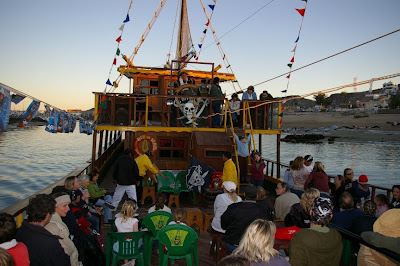
The late afternoon shadows cut across the harbor like swords drawn for battle. With little time to spare, I leaped heroically on board the pirate ship El Rey Del Mar. My wife, daughter and daughter's friend were being led to the front of the ship and I had to stop this madness before they hit the open sea.
"Avast ye!" I yelled. "Unhand those fair maidens or I'll, I'll … oh, okay. Sure, I'll take a margarita."
The young man looked at me rather strangely, and then went back to the galley to get our drinks. I plopped down on the bench next to Julie, while my fantasy dissolved into the briny air.
Okay, so they really weren't kidnapped. In fact I had to pay to get them on board, but it was money well-spent.
We had joined the crew of the Rey Del Mar on a New Years Eve sunset cruise out of Puerto Penasco. Captained (and owned) by Juan Antonio Sanabria, the Rey Del Mar is one of several boats the company uses for party cruises. It also has the most character, decked out with so many Jolly Rogers, eye patches and buccaneers that you'll be shouting "Yo ho ho!" in no time.
Once at sea the crew fills you with food and beverage, and gets you involved in playing audience-participation games (you know, the type of situation where you're not afraid to ham it up because you already are feeling "enthusiastic" from the margaritas. Not that I would know.)
It's a lot of fun and I would highly recommend it for a memorable diversion. Captain Tony also has a second ship, El Rey Del Mar II, which is currently docked in Guaymas ready for more swashbuckling action.
For more information, contact Del Mar Charters at 520-407-6054.
10/13/08
Alamos hit hard by Norbert.
Hurricane Norbert came ashore on mainland Mexico near Yavaros, Sonora. There's no doubt that Yavaros, Huatabampo and Huatabampito have sustained damage. The main news I'm finding though is about major flooding that roared through Alamos in the hills above Navojoa. Sadly, the press is reporting that four people lost their lives.
Here' a link to some photos of the damage in Alamos.
The road from Navojoa to Alamos was damaged, but El Imparcial, the Hermosillo paper, is reporting that the road is now open (barely) to allow emergency relief vehicles to get to the town.
Our hearts go out to everyone impacted by this disaster.
10/10/08
Hurricane Norbert, can I ask you a favor?
There's a lot of wind and a few clouds showing up here in Tucson today and it makes me think of Hurricane Norbert (although I doubt they are related.) Right now, Norbert is heading for southern Baja and the National Hurricane Center has issued a Hurricane Warning for the west coast of southern Baja. The storm is then projected to cross over the peninsula and hit mainland Mexico as a tropical storm somewhere between Topolobampo and Guaymas.
Now I certainly hope Mexico is spared devastation from Norbert and I'm really asking Norbert to please, please spare Guaymas. Not just because I'm concerned for the residents, including my new blogging friends Brenda and Roy. I also don't know if I could live with the guilt.
You see, my family and I have a "hurricane attraction" track record. Several places we have traveled to, have been subsequently nailed by devastating hurricanes. To wit:
1988. Category 5 Hurricane Gilbert causes massive destruction as it slams into Cozumel and the Yucatan Peninsula, 14 months after Julie and I rambled around there during our honeymoon. From what we hear, one of the places we stayed at in Playa del Carmen is destroyed.
2002. Category 4 Hurricane Kenna damages or destroys 95 percent of the buildings in San Blas, Nayarit, 13 months after Julie, Ginger and I left the village. The Hotel Garza Canela, where we stayed, apparently survived.
2004. Hurricane Frances hits the Bahamas as a Category 3, 13 months after our trip through Exuma and Nassau.
2005. One month after we had yielded to desire (okay, played the role as jazz-loving, cocktail-sipping tourists) in the French Quarter, Hurricane Katrina blasts New Orleans as a Category 3.
2005. Two months after we had spent the night socializing with locals in Holly Beach, Louisiana, Hurricane Rita scored a bulls-eye on the little vacation village. The town was completely obliterated. Gone.
2006. Hurricane John hits southern Baja as a Category 2. Two weeks earlier, Julie and I had been about 300 miles north of where it made landfall. (I know that's pretty far away but hey, when you've got a pattern going it's hard to let go).
2007. We went fishing in the White Mountains of Arizona.
However, and this is point, we were in Guaymas at the end of December, 2007. I really shouldn't be admitting this.
9/30/08
Ten fun facts about Sonora: What you should really know.
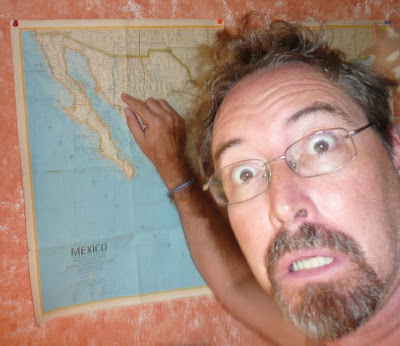
I frequently see questions online from people seeking information about Mexico for school papers or whatever. I thought I would contribute some facts about Sonora. First, according to Encyclopedia.com:
- Sonora is the second largest state in Mexico with an area of 70,484 square miles.
- Hermosillo is the capital.
- Sonora is the most heavily irrigated state in Mexico.
- Sonora is a leading national producer of cotton and wheat.
- Cattle raising and fishing are important industries.
Of course, you're going to want to pepper your paper with some fun facts as well if you're really going for a good grade. Here are 10 fun facts I've gleaned from personal experience or observation while traveling in Sonora.
Fact 1: A drunk, American retiree will fall on his face in Puerto Penasco as easily as a drunk, American college kid.
Fact 2: If you're really hungry and stop in desperation at a dirt-floored, roadside restaurant outside of Hermosillo (where your daughter refuses to eat) and order a watery shrimp cocktail, you will pay. Dearly.
Fact 3: The boulders you just avoided in the road, thus saving your front-end as you were coming around a curve outside of Magdalena, did not roll down from the hillside as it would appear. They were placed there intentionally by the local road crew as a safety warning about the roadwork ahead.
Fact 4: There are exactly seven Coronas, four margaritas, three tequila shots and one late-night beef taco in a Rocky Point hangover.
Fact 5: Contrary to what the nice man says, the bright-yellow plastic turtle that you are eyeing in the Nogales market was not hand painted by his uncle in Guaymas.
Fact 6: Per the bright-yellow plastic turtle in Fact 5; contrary to what the nice man says it is not "almost free."
Fact 7: The intoxicated woman who jumped up from her table at a crowded Manny's Beach Club and frantically yelled "There's a whale! There's a whale!" is actually pointing at two kids snorkeling.
Fact 8: After drinking exactly four cervezas on the balcony of your condo, you will have figured out how to quit your job, move to San Carlos and make a living picking up seashells.
Fact 9: You may find out the hard way that the smiling woman sitting in front of the PEMEX bathroom with a roll of toilet paper is not insane, but is actually your friend. For a peso or two.
Fact 10: Sixty-three percent of U.S. citizens become 37 percent stupider when they cross the border. Particularly, but not always, during Spring Break in Puerto Penasco.
That's all for now. Good luck on your paper. Or whatever.
9/25/08
Pets in Mexico: How do you say “woof” in Spanish?
Okay so we haven't taken our dog into Mexico because, frankly, she's psychotic. (Oh, sorry, she has “socialization issues.”) She's a mid-sized mutt and enjoys nothing more than defending her territory while boasting how she has the upper hand in the human/canine relationship.
 |
| Dessy waits patiently for her owners to deliver another souvenir. |
So while we're busy chasing sticks thrown into the Gulf of California surf, our hunk of shedding bark is lounging with her playmates at The Sabino Canyon Pet Resort. Some dogs have it better than others.
Most of the people I meet who bring their dogs to Mexico own a little forearm-sized ball of yapping fur. They can hold these creatures in one hand, and easily pack them -- out of harm's way -- in an RV or travel kennel.
Okay, so I'm not an expert on bringing your pets into Mexico. But I did do some sniffing around and ran across a Web site, Gringo Dog Travels, which lists some hotels that accept pets in Mexico. It was updated in July and could be handy information if you're planning on taking Fifi along for her much-deserved vacation. You should probably verify that the hotel still accepts pets before you go.
What about crossing the border, you say? According to the U.S. Embassy in Mexico:
“You will need a certificate of health for the pet issued by a certified veterinarian issued within fifteen days of departure. You also need a valid certificate of vaccination showing that your pet has had all its vaccinations within fifteen days of departure.
It would be best to call Mexican government offices directly for complete information. Contact the nearest Mexican Consulate in the United States, or the “Dirección General de Inspeccion Fitozoosanitaria” in Mexico City, Tel. 011-52-55-5571-3124 Fax 011-52-55-5784-3231.”
Bringing your pets back into the U.S. is another matter. The U.S. Customs Service has an online brochure which provides the details for bringing dogs, cats and other animals into the U.S. Take a look here:
Pets and Wildlife: Licensing and Health Requirements.
Well good luck and chow -- er, I mean "ciao" -- for now.
9/17/08
Finding a personal gem in Nogales.
We went camping this past weekend at Patagonia Lake State Park near the Mexican border. It wasn't hard to talk ourselves into popping over to Nogales, Sonora for a few hours on Sunday at Sr. Amigo.
Sr. Amigo:
1. After the border turnstile, turn right, walk down Internacional Street to Benito Juarez.
2. Left on Benito Juarez to Campillo. Cross Benito Juarez then cross Campillo (careful!) and walk along Campillo until you can turn left up an alley (before you get to Avenida Obregon) lined with vendors.
3. Run the gauntlet to Sr. Amigo which is on your right.
 |
| Have a drink, watch the show. |
One of our favorite pastimes is sipping beers while watching gringos run the vendor gauntlet.
"Hey come see my shop."
"Lowest prices in town."
"If I don't have what you're looking for, I'll steal it for you."
Julie nodded at an exasperated man, hunched over with shopping bags in both arms, who was trying to keep pace with a gray-haired woman. The woman seemed to ignore him as she pointed her head this way and that.
"That man looks like all he wants is a drink," Julie said.
A few minutes later he plopped heavily down at the table behind us.
"Can't find my wife," he moaned. "She went into that shop and disappeared."
He ordered a beer, drained it in five minutes, gathered his bags and trudged off.
Years ago, Julie and I burned out on shopping in Mexico and vowed to stop buying anything that we couldn't immediately put down our throats. We haven't always been successful at this, and as the afternoon shadows crept over our table I slipped on our vows once again.
A man, who was so quiet that I didn't even hear him approach our table, held a rectangle in front of me. I was transfixed. It was a small painting of two snow-capped mountains which I immediately recognized.
Last fall, I went on a trekking/mountaineering trip with two friends to Pico de Orizaba, the highest peak in Mexico. This giant volcano plumps up on the eastern edge of the state of Puebla. To the west are the second and third highest peaks in Mexico: Popocatépetl and Iztaccíhuatl. These were the two peaks in the painting.
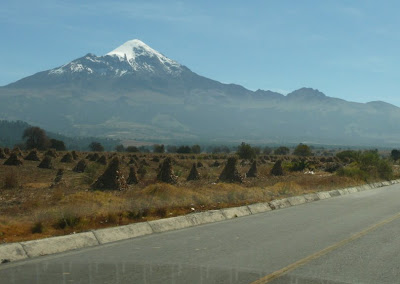 |
| Pico de Orizaba rises above the cornfields of Puebla. |
Those three massive volcanoes border the Valley of Puebla, a high rolling landscape of agriculture and history where pyramids of cornstalks line fields once traversed by Spaniards on their way to conquer Mexico. When I was there, the air was like a blue, hazy coating.
 |
| Popocatépetl and Iztaccíhuatl from the slopes of Orizaba. |
And what stopped me in mid-swish, what made me abandon (temporarily) my Dos Equis, was that the artist had captured the color and light exactly as I remembered. He had captured the air.
 |
| Ruben Huerta's painting captures the air. |
The quiet man was the artist: Ruben Huerta. He is originally from Mexico City where he received mentoring from a famous painter whose name I did not catch. He showed me newspaper clippings of articles about himself and his brother, another landscape painter. He had traveled to the frontera to make money, but complained that people here did not appreciate art. Mexico is full of talented artists with nowhere to go.
I immediately bought the painting. He had one other that showed the teepee-like cornstalk stacks so prevalent in the Valley of Puebla, but I had to have the first one.
Sure I broke our no-shopping vows, but sometimes a little gem appears in an unlikely place and you just react. Now to find a place to hang it. Hmmm.
9/8/08
Road trip! Mexico gas prices still lower than U.S.
The good people at the Discover Baja Travel Club posted recent Mexico gasoline prices observed in El Rosario, Baja. According to their research the price for Magna, the equivalent to regular unleaded, is about $2.83 per gallon. That's U.S. dollars, not pesos.
How does this compare to the U.S. border states? According to the American Automobile Association's Daily Fuel Gage Report, the average price for regular unleaded as of September 8, 2008 is:
Arizona: $3.57 per gallon
California: $3.86 per gallon
New Mexico: $3.69 per gallon
Texas: $3.52 per gallon
Many U.S. residents who live close to the border are capitalizing on the lower prices by popping over to Mexico and filling up their tanks. However U.S. Customs has said that if you go to Mexico solely to purchase fuel, it must be declared when crossing back into the states and is subject to importation requirements.
As you may or may not know the gasoline industry in Mexico is controlled by the government and PEMEX, which is an acronym for Petróleos Mexicanos, is the nationalized petroleum company. Thus prices are standardized across the country.
Unless you find yourself on a remote backcountry road running on "E." (Why are you about to be stranded this way? Is it because you overheard a conversation in a Tucson bar talking about a mythic beach south of Kino Bay? Is it because you listened to a helpful, but misguided, local who told you "Oh, it's not that far" when you asked directions?) Then, if you're lucky, you might find a grizzled ranchero who drives to town once a week to fill up a barrel for just such an emergency. At this point you should be aware that his price per liter will not conform to state regulations.
9/4/08
What is that? A Sonoran icon.
As you cruise into Hermosillo from the north on Mexican Highway 15, you'll pass a dynamic silhouette of a figure sprouting horns.
What was that?
Could it be a version of that classic southwest cliché Kokopelli, smoothed out a bit to give it a regional spin?
A sign promoting the next lucha libre event in town?
Well, "no" and "no." What you've just passed, while worrying about missing the turnoff for San Carlos, is a representation of a Yaqui Deer Dancer.
The Yaqui are a Native American people who originally inhabited the Rio Yaqui valley and surrounding regions in Sonora. The Yaqui today still perform the Deer Dance ritual during ceremonies throughout the year, particularly during Easter.
According to Muriel Thayer Painter's guide "A Yaqui Easter," the dance originated as part of "hunting rituals held on the night before a deer hunt. It is believed that these dances and songs persuaded the deer to give himself up to the hunter."
Sonora has adopted the Deer Dancer as its state symbol, and you'll see him on the state flag and elsewhere.
So now you know.
Learn more about the Yaqui people here.
8/25/08
Will Puerto Penasco travelers have to wade across the border?
Here's a little side effect of the controversial border fence that I didn't hear about until today. According to a report released by officials with Organ Pipe National Monument, the 15-foot high fence blocked flood waters from a July 12th storm and flooded the international border crossing. Property was damaged in both Lukeville, Arizona and Sonoyta, Sonora. Apparently, debris quickly blocked the holes in the bottom of the fence that were designed to let the water flow through.
 |
| Photo: AP/National Park Service |
I'll save my opinions about the border fence issue for another time and place. (How about over a cold Bohemia at the Marina Cantina in San Carlos?) It does make me wonder, though, if we need to check a weather report before heading to Puerto Penasco.
"Did you get the passports?"
"Yes dear."
"Mexican auto insurance?"
"Yes, pumpkin."
"Sunscreen?"
"Of course, my flowering lily."
"Waders?"
"Damn!"
Hey, here's a scenario. You're driving back to the United States on a Sunday afternoon after dawdling too long at Manny's, and you see dark clouds hovering over Gringo Pass ("I told you we should have left earlier, dear").
Will that 45 minute wait to go through customs turn into hours?
Will street vendors glide past your window in makeshift dugouts, poling along with one hand and balancing a painting of the Virgin of Guadalupe in the other?
Just think, the term "port of entry" could take on a whole new meaning.
8/22/08
San Carlos kite boarding: Fun to watch, but ...
The gut-wrenching news footage this week of a kite boarder being yanked helplessly across the sands by ferocious winds in Florida, reaffirmed a decision I made before New Years about trying the sport:
Hell no.
If you go up along Los Algodones (Catch 22) Beach in San Carlos, you'll see a sign pointing to the Hangout beach bar, just before Paradiso. Follow a little dirt track and there is The Soggy Peso bar, a perfect little beach bar with outstanding ceviche. Grab a beverage and plop down on a beachside table facing a pretty bay.
Julie and I did just that, after stumbling across The Soggy Peso last December.
"Gee, it sure is windy," I said.
"Sure is," she replied. (Sitting on a Mexican beach tends to stunt intellectual conversation.)
We watched as a few men and women started laying out some sort of fabric on the sand.
"Wonder what they're doing?"
"Dunno."
"Windsurfing?"
"Dunno. Maybe."
"Another beer?"
"Well, yeah."
Another beer later and a light bulb flickered:
"I bet they're kite surfing," I said proudly.
Julie looked at me and I could see the admiration and respect in her eyes when she realized I had figured it out.
"Maybe," she said.
Anyway, things got pretty exciting after that as these "kiters" entered the bay and shot across the water. With their kite pulling them like an untrained Great Dane out on a walk, they cruised away from shore then turned and started heading straight for the beach.
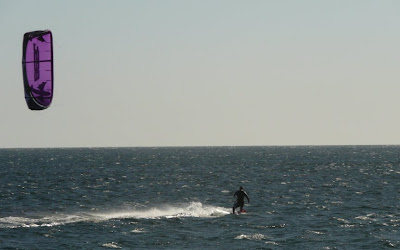 |
| Kiting in San Carlos. Photo: Julie Lunt |
"This is going to be interesting," I thought. And it was, because just as one guy was about to eat sand he turned parallel to the beach and then did something completely unexpected. He flew up about 15 feet above the water.
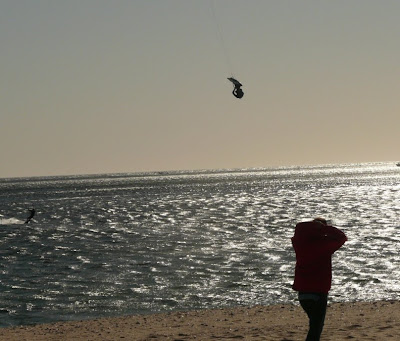 |
| Up, up and away! |
Julie and I looked at each other. "Whoa!"
Now here's an activity I had never really paid attention to, but this was cool! The speed and power and grace were amazing.
"I've found my new sport!" I proclaimed to Julie as I tipped another Dos Equis. I turned to our waiter. "I want to learn to do that. Do you do this?"
"I tried it once," he said. "I won't do it again."
"Why not?"
"I was dragged along the beach," he said.
"Dragged?"
"Along the beach. It hurt."
Our waiter was a good twenty years younger than me, and even through my alcohol-exaggerated bravado, I started to question the sport. By the next morning, I had decided that the kite boarding world didn't need me.
But you may want to try it. From what I understand, there are people giving lessons in San Carlos. Just inquire at The Soggy Peso. Or simply order a margarita, grab a table and watch the show.
8/21/08
Puerto Penasco and Sandy Beach camping blues
Well if you are a Sandy Beach camping aficionado, you're probably aware that the days of "road warrior" camping are pretty much over.
Like mushrooms, high-rise condos have been springing up almost overnight as this famous (infamous?) stretch of sand has transformed from an unruly rite of passage for young Arizonans, to world class resort (almost). And if you're only getting the news now, I'm sorry.
 |
| Camping on Sandy Beach, looking SE. |
Of course one person's loss is often another's gain, and both Mexicans and Americans stand to gain a lot from this new Sandy Beach. It's created jobs and other opportunities to make money. It's created a new destination in Mexico that will appeal to vacationers both south and north of the border. And the condos are way swanky. (Okay, I'll admit it. After four days trekking from the Pinacates to Sandy Beach, four of us splurged and rented a condo in the Princesa Condominiums. It was a delightful end to a great wilderness walk.)
But the sad fact remains that beach camping opportunities in Rocky Point are disappearing fast, and will most likely be completely gone in the near future. Right now, The Reef RV Park is the only place on Sandy Beach where you can still experience the "drive up and stake it down" camping of the past. The park is located at the western end of the beach. It has developed sites for RVs and tent camping, plus allows you to camp directly on the beach.
In May, we paid $5 per night to camp in a surviving stretch of open beach between the walls of approaching condos and the park's large, disco bar. Of course, you can also get beach front camping in the developed sites.
As far as eating goes, the Reef bar has a little snack stand that features delicious -- and inexpensive -- tacos. There is also a gourmet restaurant which is an anomaly: Incredibly delicious cuisine, at good prices, cooked by a master chef in an unlikely location.
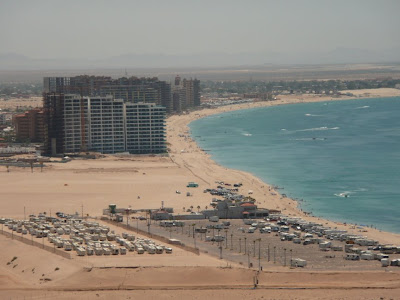 |
| Sandy Beach and The Reef RV Park. |
I don't know how long this stretch of sand will hold out against the onslaught of development. And, to be honest, I actually found the partying atmosphere a little noisy and tiring. But then I may be getting old.



